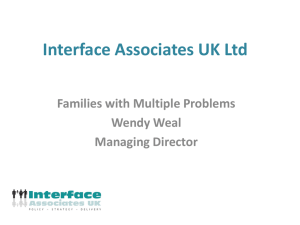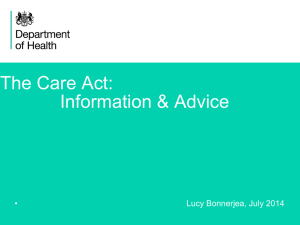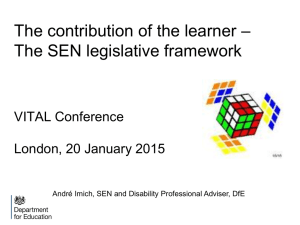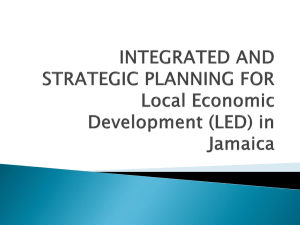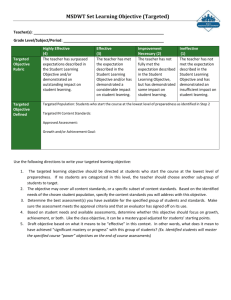Rationale and outcomes for services for young people
advertisement
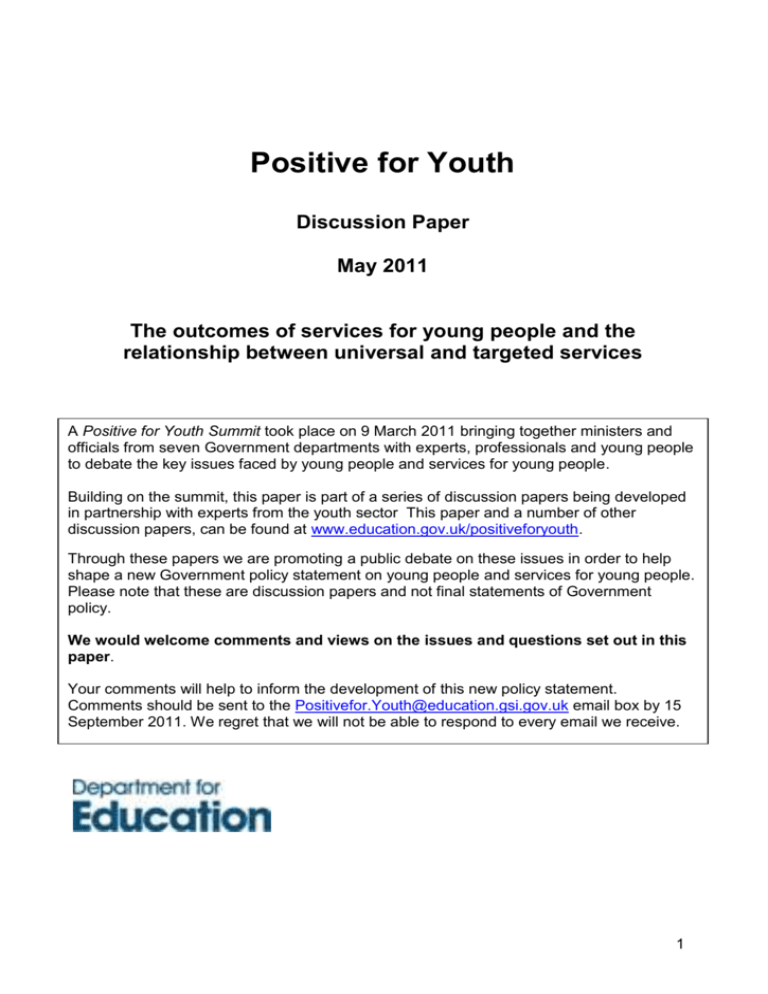
Positive for Youth Discussion Paper May 2011 The outcomes of services for young people and the relationship between universal and targeted services A Positive for Youth Summit took place on 9 March 2011 bringing together ministers and officials from seven Government departments with experts, professionals and young people to debate the key issues faced by young people and services for young people. Building on the summit, this paper is part of a series of discussion papers being developed in partnership with experts from the youth sector This paper and a number of other discussion papers, can be found at www.education.gov.uk/positiveforyouth. Through these papers we are promoting a public debate on these issues in order to help shape a new Government policy statement on young people and services for young people. Please note that these are discussion papers and not final statements of Government policy. We would welcome comments and views on the issues and questions set out in this paper. Your comments will help to inform the development of this new policy statement. Comments should be sent to the Positivefor.Youth@education.gsi.gov.uk email box by 15 September 2011. We regret that we will not be able to respond to every email we receive. 1 The outcomes of services for young people and the relationship between universal and targeted services Summary This paper identifies the main types of services which young people use. It explains what benefits they are trying to achieve for young people. It distinguishes between services which are for all young people such as schools and colleges, and those services which are for smaller numbers of young people with particular needs. It says that the Government wants public money for out-of-school services to concentrate more on helping the most disadvantaged, and that it would like to see more voluntary organisations delivering services to young people. This paper asks how services can best use the skills of youth workers now local services for young people are changing. It asks how all services can best work together to identify and serve young people who need extra help. It asks how services for young people can work with their parents to make a difference. We want to know you think. The paper also asks for examples of where services are working well for young people so we can tell everyone about them and other areas can learn from this. Introduction 1. This note seeks to identify the services which are the subject of the Government’s reform strategy for youth services. It identifies the outcomes for young people which those services can influence. It examines the respective roles of universal and targeted services and how they relate to each other. Background Services to young people 2. There is a wide range of services to young people to age 19 which include: (i) the core educational offer by schools and colleges and associated specialist education providers eg special schools and Pupil Referral Units; and also NHS services such as GPs, hospitals, health promotion and associated specialist services such as sexual health; (ii) positive activities to engage and develop young people, which may be supported by national or local government funding, or provided independently of government. These include general and specialist youth clubs, sports and leisure activities, cultural arts activities, holiday activities and after school clubs, and National Citizen Service; (iii) youth services funded by local authorities (LAs) which aim to contact and deliver outcomes for young people locally, often through distinctive youth work methodologies delivered by youth workers; 2 (iv) information, advice and guidance services on educational and career options, currently funded by LAs, and which schools and colleges will be expected to make available in future; (v) targeted services to address disadvantages such as Special Educational Needs or disabilities and early intervention services aimed at preventing poor outcomes for those identified as at risk eg to prevent early disengagement from learning, involvement in crime or anti-social behaviour, teenage pregnancy, alcohol or drug misuse or obesity. This includes support for young people who are out of work to help them to find a job, such as access to job search support, employment-focused training opportunities and work experience, help to find a volunteering placement, and, for 18 year olds, priority access via Jobcentre Plus to the new Work Programme which offers tailored, personalised support to make the transition into sustainable employment; and (vi) intensive specialist services for young people who are in difficulty and who need high levels of intervention to prevent harm to themselves or others eg care and other social services, family intervention, mental health, specialist drug and alcohol services, secure accommodation, Youth Offending Teams. Outcomes 3. Under the previous Government’s Public Service Agreement on Youth, national and local agencies were required or encouraged to commission services to improve outcomes against the following measures: participation in positive activities, young people who are not in education, employment or training (NEET), teenage pregnancy, first time entrants to the criminal justice system, and young people frequently using drugs and alcohol. 4. The Coalition Government is committed to increasing the aspiration and attainment of young people. In particular it is committed to improving standards and achievement at age 16, the participation of all 16 and 17 year olds in education and training, raising the participation age to 18 by 2015, and fully funding training for young people up to the age of 24 to achieve a first full level 2 or 3 qualification or Foundation Learning programmes for those who need a step up. This will help to ensure that all young people have the qualities, skills and qualifications they need to succeed and that we have the skilled workforce we need to compete globally. 5. While the previous top-down regime of national targets has been dismantled, it is important that local areas have access to information they need to monitor progress and benchmark against others. The Department for Education has issued statutory guidance making clear its expectation that LAs will continue to collect information on young people NEET. Young people NEET and teenage pregnancy and crime reduction are proposed indicators within the NHS and public health outcomes frameworks, and first time entrants to the criminal justice system and reducing youth re-offending are Ministry of Justice impact indicators. Detailed information on the effectiveness of young people’s drug and alcohol services is collected for each local area through the National Drug Treatment Monitoring System, and harms from young people’s alcohol use will be included within the public health indicator for alcohol-related hospital admissions. 3 Universal services 6. Educational attainment is the outcome for young people with the strongest correlation to their life chances as adults correlated. The core role of schools and colleges is to enable their students to attain and the Government wishes to free up schools and colleges to focus on this role. Strong relationships with teachers and good subject teaching can help build motivation to learn. Through their experiences of learning and wider school and college life, students develop their maturity and character and are prepared for adult life. 7. Schools remain an important source of extra-curricular positive activities for the majority of young people, particularly those from low-income families. Funding that has been provided for extended services through the DfE Standards Fund now forms part of the overall schools revenue baseline. The funding is not earmarked specifically for extended services so schools have greater flexibility to use it as they think best to support their pupils. However, the Schools White Paper “The Importance of Teaching”, (November 2010) makes it clear that the Government will “rely on schools to work together with voluntary, business and statutory agencies to create an environment where every child can learn, where they can experience new and challenging opportunities through extended services, and where school buildings and expertise are contributing to building strong families and communities”. 8. The Schools White Paper makes clear that good schools play a vital role as promoters of health and wellbeing in the local community. They create an ethos focused on achievement for all, where additional support is offered early to those who need it, and where the right connections are made to health, social care and other professionals who can help pupils overcome whatever barriers to learning are in their way. Schools may draw on the expertise of local children’s services, the local NHS and Public Health England, but they will be the best judge of how to meet the needs of their pupils. 9. Further Education Colleges, often working with local health services, police, and community groups, also provide a full programme of tutorial support and enrichment activities for those on full time courses typically including artistic, cultural, sporting and volunteering activities. Where colleges choose to extend tutorial and enrichment programmes to over 18 year olds, these are particularly valuable for young adults who may have experienced an interruption to their education and/or have been NEET for a period, ensuring that they get the full support they need to complete their transition to adulthood. 10. As the primary universal service for young people, in addition to supporting personal and social development, schools and colleges have a particular role to play in raising awareness of the risks of certain behaviours – for example carrying knives, consuming drugs or alcohol, risky sexual activity, or running away from home, and promoting the benefits of other behaviours – for example healthier life styles or participation in organised group activities. 11. Although not available in every locality, open access services such as youth clubs and youth centres can play an important role in providing young people with safe places for leisure as well as opportunities for personal and social development and involvement in the community. They are a non-stigmatising setting in which to identify young people who need more intensive or specialist support, for example, 4 young people who may have significant caring responsibilities at home. The Department for Education is committed to a number of significant capital projects funded through the myplace programme that will increase significantly the quality of local services outside of school or college for young people in some of the country’s most disadvantaged areas. In 2011 and 2012 the Government is piloting National Citizen Service for 16 year olds as a potential universal offer of social mixing, personal challenge, and community service. 12. Youth workers and youth work approaches have a valuable role to play in helping vulnerable and disadvantaged young people achieve their potential in these and other settings, such as multi-agency children’s services teams, family intervention, school and college inclusion services, and alternative education. These approaches help young people develop relationships and decision-making skills which in turn help them achieve good outcomes in relation to education, employment and citizenship. As services change, and particularly where existing services close, it will be important that other services to young people consider the benefits youth workers and youth work methods can bring. Targeted services 13. Targeted services have an important and specific role to play in combating disadvantage. The Government is currently consulting on specific proposals in relation to Special Educational Needs through its Green Paper “Support and aspiration: a new approach to Special Educational Needs and Disability”. 14. Early intervention services also aim to prevent and address negative outcomes such as non-participation in education, employment or training; involvement in crime or anti-social behaviour; poor mental health; poverty; substance misuse; obesity; or teenage pregnancy. Early intervention is central to the Government’s commitment to unlock social mobility, tackle child poverty, and break the cycle of health inequalities by reducing the chance that disadvantages experienced by one generation are passed on to the next. Graham Allen’s review of early intervention is looking at ways to promote evidence-based approaches to intervening early in the lives and families of children and young people to address problems before they become entrenched and result in long term damage. This means both investing in the early years and continuing to intervene early if and when things go wrong in the teenage years since some negative behaviours or outcomes precipitate from later events and cannot be predicted by prior risk factors. 15. Evidence shows that there is significant overlap in the risk factors that drive negative outcomes such as becoming NEET for a extended period, continuing spells of unemployment in adulthood or living in poverty – for example 15% of young people aged 16-18 not in education, employment or training are teenage mothers. In total, around 7% of young people experience three or more risk factors. 16. Disadvantage for young people is often a consequence of poor parenting and family based problems including domestic abuse, parental substance misuse, and parental mental health problems. An effective response is joined up, whole family interventions that address young people’s problems along with their wider family needs. The Prime Minister has committed to try and turn around every troubled family by the end of this parliament. All local authorities are being supported to develop a new approach to supporting families with multiple problems through the 5 role out of community budgets. 17. Effective targeted services are those that intervene early through a structured evidence-based approach to address the underlying causes of problematic behaviours. Where there are multiple problems, key workers and lead professionals can play a vital role in co-ordinating interventions aimed at young people and often also their families, increasing young people’s access to a wide range of services, reducing the duplication of resources, and mitigating the risk that young people around the age of 18 fall into the gap between children’s and adult services. 18. Young people, particularly those experiencing or at risk of significant negative outcomes, need positive role models. Social mixing can help young people develop positive peer relationships, and it is important that young people also develop good relationships with adults that they trust – including through mentoring arrangements with adults in the community. What needs to change Services to young people 19. The Government has already set out its approach to core education and health services and to information, advice and guidance services, in other specific publications such as the Schools White Paper. It will set out its approach to specialist services to young people in separate documents focusing on the detail of these issues. The main scope of this note is therefore on services described as positive activities, youth services and early intervention services. 20. Where publicly-funded, these services to young people are for the most part commissioned by LAs, though some will be commissioned by Primary Care Trusts or the Police. Joint commissioning between these bodies is also widespread. LA and other public agency staff are often in the lead in delivering these services, although voluntary and community sector bodies will usually deliver a minority and sometimes the majority of publicly funded services in an LA area. There is substantial provision of “positive activities” which is not publicly funded. Often the organisations delivering these activities will define themselves by their core interest – faith, sports, arts, locality etc – rather than seeing themselves as part of a “youth sector”. Outcomes 21. While the scale and pattern of local provision of services to young people is principally for LAs to determine, LAs legitimately look to Government for its views on what public policy outcomes such services should aim to further. The Government believes that raising young people’s aspirations and attainment is the most important thing for helping them reach their potential. So it sees services for young people as having three main roles: (i) to make sure young people at risk of dropping out or underachieving take part and succeed in learning; (ii) to prevent crime and risky behaviours such as teenage pregnancy and substance misuse which can undermine young people’s life chances and have a cost to wider society; and 6 (iii) to provide opportunities for those young people who don’t otherwise acquire them to develop the personal and social skills they need for learning, work and transition to adulthood. These skills include self-regulation, relationship-building, and decision-making. 22. Nationally available local indicators which local areas can use to measure progress and benchmark against other areas include 16 and 17 year olds who are NEET, teenage pregnancy, first time entrants to youth justice system, data on those in drug and alcohol services and youth reoffending rates. Are these the right outcomes for local services to young people and are these the best indicators of progress? Universal and targeted services 23. Through the Early Intervention Grant the Government has signalled through its overall policy steers that in an era of more limited public funding availability: public funding should be focused on the provision of targeted support for young people at greatest risk of poor outcomes, following the principle of early intervention; a greater share of publicly-funded activities should be delivered though voluntary and community sector providers to increase competition, responsiveness and innovation, and bring more new ideas and local people into delivery. 24. The Government is not consulting on this general approach. However it is concerned to explore the implications particularly with LAs and the VCS sector. What are the practical implications of focusing public funding on targeted support and greater diversity of providers and how these might best be addressed, including: (i) how can LAs and central government best enable community organisations to offer positive activities to local young people? (ii) what local arrangements for identifying young people who need targeted support are likely to be most effective? (iii) how can continuity of support be achieved for young people, particularly in the transition to adult services? and (iv) how can the expertise of youth workers and other professional staff and youth work approaches best be utilised? 25. Parents and families are the strongest influence on their children including when they are teenagers. Family services and intervention are significant in preventing and addressing poor youth outcomes. This includes both helping parents support their teenagers (good parenting supports both attainment and wider personal and social development), and addressing parents’ own negative outcomes that impact on young people (evidence shows that children of parents who have drug and alcohol 7 problems, poor mental health or are involved in offending or domestic violence are at a high risk of future problems). 26. A growing body of research has shown that family or parent training can result in measurable reductions in youth crime, antisocial and delinquent behaviour, child maltreatment, underachievement at school, and child and adolescent mental health problems. It also shows that intensive family interventions and parenting programmes can reduce risk factors in families, improve outcomes for children and young people, and reduce the burden of cost these families place on local services and wider society. 27. While there are circumstances in which a strong one-to-one relationship between the individual young person and an employed professional worker can be central to positive change, services which focus on the family unit in which young people live can be crucial in bringing about positive change. The Government is keen to explore further how improved links with parents and with family services can help address young people’s needs and prevent problems worsening. For example many LAs are expanding interventions with families with multiple problems, many of whom will have teenage children, and some are deploying youth workers within multi-agency locality teams which provide early intervention services to families. How can local services best engage with parents and families to prevent poor outcomes for young people? Who are the key players? 28. The role of Government is to set the policy framework for services for young people, allocate available central government resources accordingly, and ensure that roles and responsibilities are clear and as far as possible consistent with wider arrangements for local government, health, youth justice, education and children’s services. 29. The role of LAs and other local strategic agencies such as PCTs is to assess the priority needs of young people locally and identify and commission effective ways to help meet them, joining up with other agencies, and monitoring and assessing service delivery. Where these are best met by in-house services LAs’ role is to deliver the best quality services within the resources available, joining up with other providers. LAs should actively seek to build the capacity and capability of local VCS bodies to deliver services to young people, both funded and unfunded. LAs collectively should help ensure that central government policy and decisions are informed by local experience. 30. There are a wide range of VCS organisations working with young people and their families, including national deliverers of public-funded services, small community bodies, faith bodies, and sports clubs and arts organisations. Their role is to deliver good quality services which meet the interests and needs of young people, consistent with their individual organisation’s objectives. Drawing on their knowledge of young people local VCS bodies should influence LAs and PCTs in assessing local needs and identifying priorities. 31. Business, philanthropists and social investors can play a significant supporting role in offering money, other resources or staff time to provide opportunities or support 8 for young people. These often have most durable impact where they involve strong and lasting partnerships with VCS organisations, schools or colleges. Existing models of good practice or innovative delivery 32. Building on the work of the Centre for Excellence and Outcomes the Government is keen itself to showcase promising or proven examples of good practice or innovative delivery. These might for example include instances of strong relationships between schools or colleges and VCS organisations which lead to improved services and outcomes for young people. It also wishes to encourage the LA and youth sector to put in place arrangements for disseminating information about these examples and, where proven, encouraging replication. Examples of good practice or innovative delivery of services for young people are invited for possible further dissemination. Questions /comments 33. We would welcome comments and views on the following questions: Are the proposed outcomes the right ones for local services to young and are the listed indicators the best measures of progress? What are the practical implications of focusing public funding on targeted support and greater diversity of providers and how these might best be addressed, including: people (i) How can LAs and central government best enable community organisations to offer positive activities to local young people? (ii) what local arrangements for identifying young people who need targeted support are likely to be most effective? (iii) how can continuity of support be achieved for young people, particularly in the transition to adult services?; and (iv) how can the expertise of youth workers and other professional staff best be utilised? 34. How can local services best engage with parents and families to prevent poor outcomes for young people? Examples of good practice or innovative delivery of services for young people for possible further dissemination are invited. Comments and views on the issues and questions set out in this paper sent to positivefor.youth@education.gsi.gov.uk. 9 Key points made through the consultation Government’s position Action Government is taking There is general support for outcomes and indicators proposed but some respondents feel they are too focused either on attainment or negative behaviours and there should be more recognition of the importance of softer outcomes such as selfregulation, relationship-building and decision-making although these are intrinsically difficult to measure. Personal and social development is one of the three aims of publically funded services for young people along with participation and attainment, and avoiding negative behaviours, both of which we also continue to believe are critically important. We will set out our recognition of the importance of soft outcomes such as decision-making and relationship-building in the policy statement, and will elaborate on our support for the emerging outcomes framework being produced by Young Foundation. Open access and targeted services should be seen as part of a single system rather than separately. If open access provision is lost early intervention will be damaged and the costs of later more intensive interventions rise, as open access settings reach many disadvantaged young people when they are in deprived areas or where young people are happy to self-refer to non-stigmatising settings. We agree that high quality open access youth settings can be effective and will encourage local areas to look at good practice in projects such as Myplace centres. It will be for local areas to assess whether open access youth provision is the right solution for their area. Most referrals to targeted provision come from other sources, and there are other important universal settings such as schools and colleges. The policy statement will make clear the potential of high quality open access services, and that where these are located in disadvantaged areas they can provide a targeted service. We will demonstrate that we understand and value the distinctive contribution of youth work. However we will make clear our view that the status quo in terms of delivery is unlikely to be an option and that local partnerships will need stronger involvement of community groups, VCS providers and businesses in providing activities and personal development for young people. Positive activities provision by the VCS can be enabled if regulatory burdens in contracting and grants are reduced, there are long-term funding agreements which are not financially onerous on the VCS providers, there is capacity-building through local intermediary bodies, and there is joint training with the statutory sector. Conditions and length of contracts or grants are matters for commissioners to determine, and we believe local commissioners should have regard to the points made. We will set out in the document the support we are providing nationally through the VCS grant and funding to Catalyst to build VCS capacity. We will also set out the action Government is taking to improve LA commissioning including through new strategic guidance, good practice dissemination on new models of delivery, and skills training for LA youth commissioners. We have issued statutory guidance to LAs not to disproportionately cut VCS provision. 10


